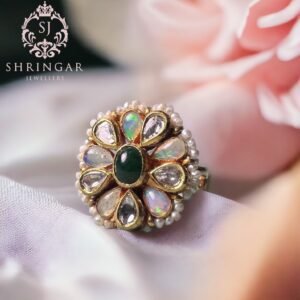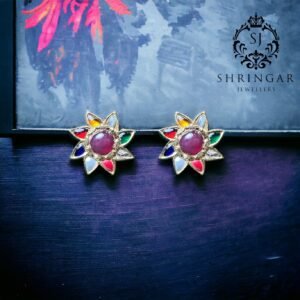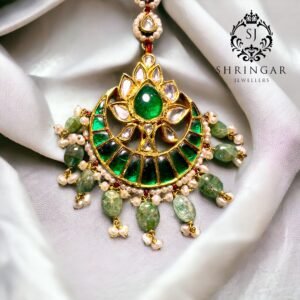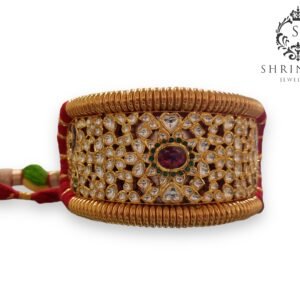Baju Bandh (Armlet) Ornament:
The baju bandh, also known as an armlet, is a traditional ornament worn around the upper arm. Rooted deeply in Indian culture, it is a piece of jewelry that holds both aesthetic and symbolic significance, particularly in the royal and aristocratic heritage of India. The term “baju bandh” comes from two Hindi words: “baju,” meaning arm, and “bandh,” meaning to tie, signifying its function as an adornment for the arm.
Historical and Cultural Significance:
The baju bandh has a rich historical background, having been worn by both men and women in ancient India, particularly in the Mughal, Rajput, and South Indian kingdoms. Kings, warriors, and noblemen would don elaborate armlets as a symbol of power, valor, and wealth, often as part of their ceremonial attire. Women, especially brides, wore baju bandh as part of their bridal ensemble, symbolizing prosperity, protection, and beauty.
Over time, the ornament became closely associated with bridal jewelry and special occasions, though it remains part of traditional attire in various Indian states to this day. In some communities, it is also believed to have protective or spiritual qualities, warding off evil spirits and ensuring good fortune.
Design and Craftsmanship:
The design of a baju bandh varies greatly depending on the region, cultural influence, and the wearer’s social standing. Traditionally, it is handcrafted by skilled artisans using precious metals such as gold and silver, often embellished with gemstones like diamonds, rubies, emeralds, pearls, or semi-precious stones like turquoise or coral.
- Shape and Structure: The baju bandh can take various forms, from a simple metal band to an intricately designed piece with floral, peacock, or geometric patterns. Some armlets are flexible and adjustable, designed as a chain with decorative elements, while others are solid, cuff-like structures.
- Decorative Elements: Many traditional armlets feature kundan or meenakari work, where precious stones are set in gold or enamel-painted designs. These ornaments may also include delicate carvings, filigree work, or motifs inspired by nature, gods, goddesses, or mythical creatures. The baju bandh is often designed to complement the wearer’s attire, such as the saree or lehenga, and is coordinated with other pieces of jewelry like necklaces, bangles, and earrings.
- Regional Variations:
- In Rajasthan, baju bandh designs often reflect the grandeur of Rajputana heritage, with bold, vibrant patterns and a heavy use of kundan and polki (uncut diamond) work.
- In South India, especially in states like Tamil Nadu and Karnataka, temple jewelry-style armlets, featuring intricate designs inspired by deities and temple architecture, are prevalent.
- In Maharashtra, traditional armlets often feature simpler, more understated designs, crafted from gold and decorated with pearls or rubies.
Modern Adaptations:
In contemporary fashion, the baju bandh has seen various modern interpretations, often worn as a statement piece with both ethnic and fusion attire. Designers may create sleek, minimalist versions using lightweight metals, allowing for more versatility. Some even incorporate innovative materials like leather or fabric, blending tradition with modern trends.
Occasion and Usage:
The baju bandh is predominantly worn during weddings, religious ceremonies, festivals like Diwali, and other special occasions. Brides in India, particularly in North and South Indian cultures, often wear baju bandh as part of their traditional wedding attire, symbolizing grace and beauty. The ornament is also common in Bharatanatyam and other classical dance performances, where it enhances the elegance of the dancer’s movements.
In essence, the baju bandh is a timeless ornament that encapsulates the richness of Indian tradition, craftsmanship, and cultural identity, serving as both a decorative and symbolic piece of jewelry that has evolved yet maintained its importance through centuries.





Reviews
There are no reviews yet.